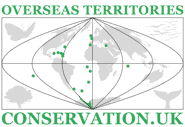East Caicos Mega-Port Construction

East Caicos is the largest uninhabited island in the Caribbean. Attention was drawn to it by a UKOTCF-coordinated series of projects from the late 1990s to early 2000s. A recent habitat mapping project, reported that: “East Caicos represents the largest continuous landmass in the Turks and Caicos Islands un-fragmented by development and, as such, is a critical reservoir of biodiversity on a community, genetic and species level.” In 2017, site surveys were conducted to quantify its natural assets further.
The North, Middle and East Caicos Nature Reserve is also designated as a Wetland of International Importance under the Ramsar Convention on Wetlands.
East Caicos is a superb complex of natural coral reefs, tidal flats, mangroves, marshlands and recovering tropical dry forest, which provide a haven for wildlife, as well as the natural basis of the fisheries and tourism industries. There are important caves and dry tropical forest. It is clear that the whole of this uninhabited island should be included in the Ramsar Site, and this was recommended in a 2005 review of potential Ramsar sites conducted by UKOTCF, in consultation with territory bodies including those in TCI, and commissioned by DEFRA, as well as local later reviews. However, this has not happened, hampered by lack of political will, and the idea of TCI politicians that East Caicos was ripe for development.
In the late 1990s, there was a proposal for development of a major port and resort development which would have covered much of East Caicos and changed the nature of the whole island. UKOTCF helped local people raise and publicise internationally their concerns at this issue. The development did not proceed, but that was probably more to do with changing economic situations than a positive success of the conservation arguments.
The then Premier of the Turks and Caicos, Rufus Ewing, and Minister of Finance, Washington Misick, first publically announced in 2013 a new intention of TCI Government to develop a trans-shipping port and cruise centre on East Caicos. (Trans-shipping ports seem to be flavour-of-the-month with many Caribbean administrations. The prospects of these being based on a small island, without a large local market to share costs, seem unlikely.) The proposal included a mega cruise port, mega cargo port and mega yacht port with resort facilities, duty-free shopping and other tourist attractions. In September 2014, the then Minister of Finance stated that the $19 million awarded to TCI from the EU development fund would go specifically to the development of the deep water port, and that the development would be strategically located to include a second cruise port. (The use of EU funds seems odd as this would normally require proper environmental impact assessments, which had not been undertaken.)
The importance of East Caicos as the most unspoilt wetland complex in the region seems to be completely undervalued. Good governance would dictate that any major development such as this would require an open, transparent and public Environmental Impact Assessment (EIA). Sadly, this has not been the case in previous developments in TCI, and there are concerns that a proper EIA will not be conducted for this proposal were it to be carried forward.
However, as it has been stated that the EU funds are going to be used to kick-start this project, it is hoped that before any development occurs, a complete, transparent and independent EIA would take place, a requirement of EU-funded projects.
Such an EIA should take account of the ecosystem services East Caicos contributes, already and potentially, to the broad economy of TCI, and include a costs-and-benefits assessment. Previous built developments, carried out without environmental review, have seriously damaged the environment and economy of TCI.
TCI needs sustainable development – its unspoilt environment is the basis of the tourism industry.
In 2015, Fred Pearce highlighted its importance in an article, with input from UKOTCF, on yale360 On an Unspoiled Caribbean Isle, Grand Plans for Big Tourist Port
The future of the island remains uncertain, but we are supporting local efforts, by the Turks and Caicos Reef Fund and others, to try and build knowledge of how East Caicos could contribute to the local economy, particularly for local persons in South and Middle Caicos, as a natural asset rather than a built development.
